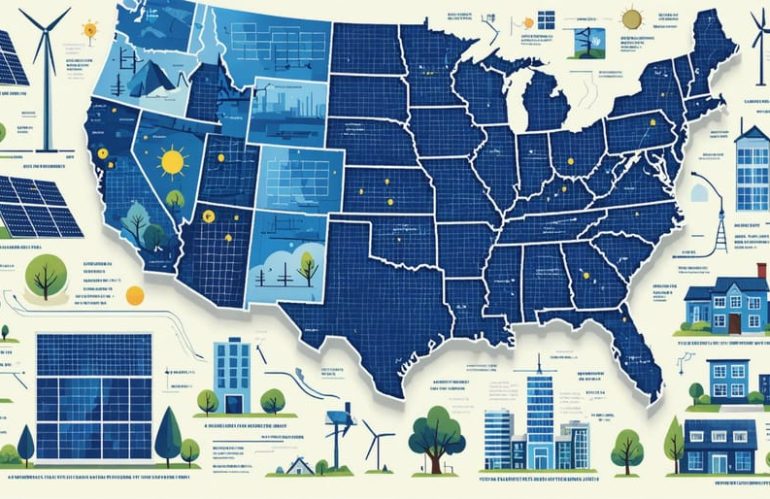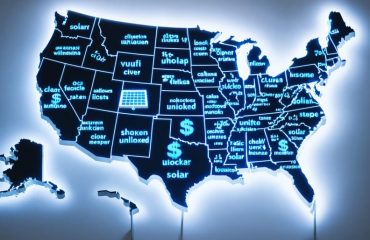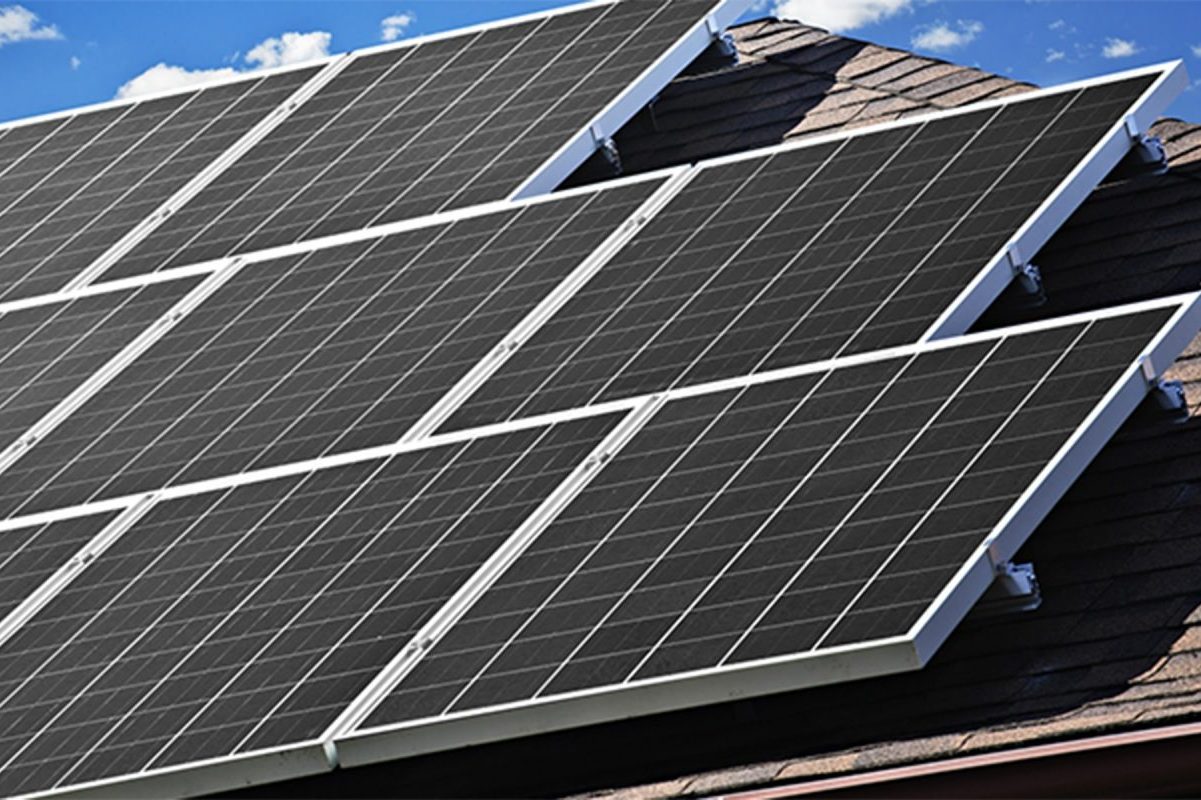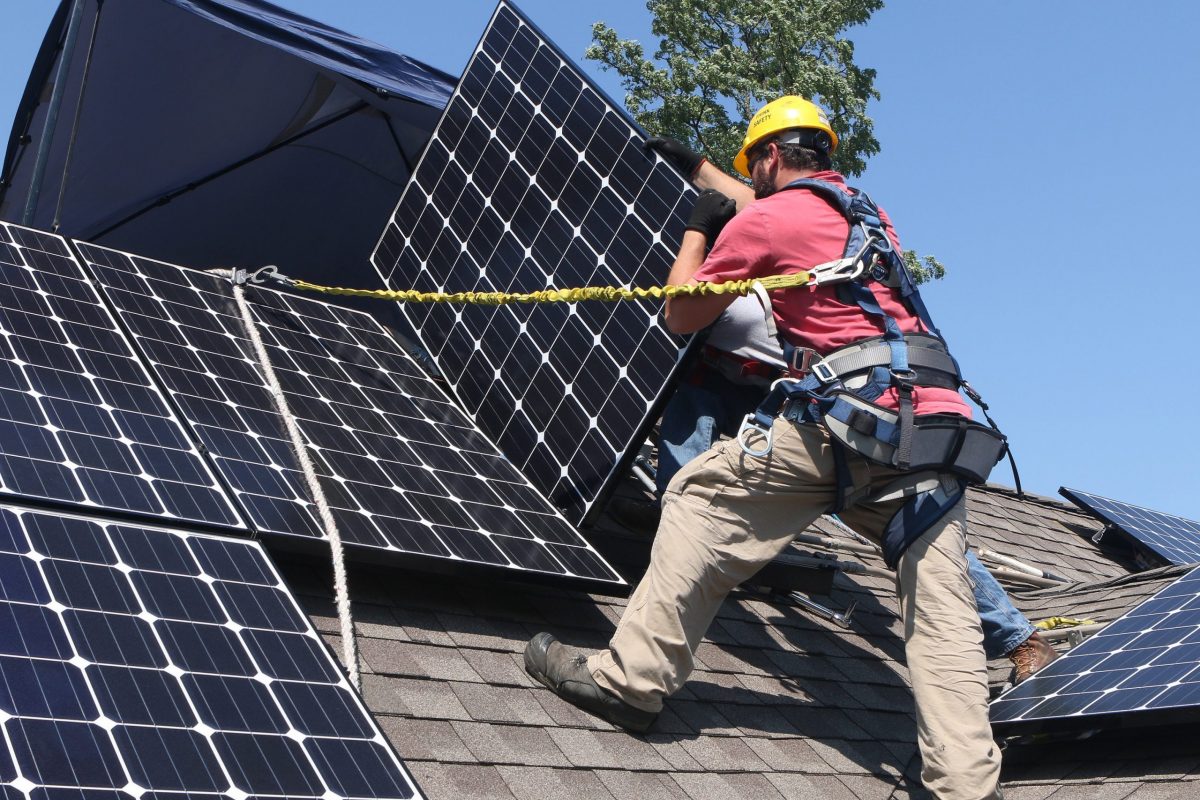Navigating solar regulations across U.S. states can make or break your home solar investment. From California’s groundbreaking solar mandate to Florida’s net metering policies, each state maintains distinct rules that directly impact installation costs, energy savings, and property rights. Understanding these regulations before installing solar panels ensures compliance, maximizes financial benefits, and prevents costly mistakes.
State solar regulations generally fall into three key categories: installation requirements, financial incentives, and utility connection policies. While federal guidelines provide a baseline, local jurisdictions often implement additional requirements affecting everything from permit costs to HOA restrictions. Smart homeowners recognize that these regulations aren’t just red tape – they’re powerful tools that can significantly reduce installation costs and guarantee long-term energy independence.
Recent changes in state policies have made solar more accessible than ever, with many states now offering tax breaks, expedited permits, and protected solar access rights. Whether you’re considering rooftop panels in sunny Arizona or a ground-mounted system in Vermont, knowing your state’s specific regulations helps you maximize available incentives while ensuring your installation meets all legal requirements.
Take charge of your solar journey by researching local regulations now, before making any significant investments or commitments.
Common Solar Regulations Across States
Building Permits and Codes
Building permits are a crucial first step in your solar installation journey, ensuring your system meets local safety standards and building codes. Most states require homeowners to obtain permits before installing solar panels, though specific requirements vary by jurisdiction. These typically include structural engineering reviews to verify your roof can support the added weight, electrical permits for system wiring, and zoning compliance checks.
The permit process usually involves submitting detailed system plans, including equipment specifications, mounting details, and electrical diagrams. While this might seem daunting, most reputable solar installers handle the permitting process for you as part of their service package. They’re familiar with local requirements and can navigate the system efficiently.
Common safety codes focus on fire access requirements, electrical standards, and structural integrity. Solar installations must comply with the National Electrical Code (NEC) and local fire codes, which ensure proper system grounding, appropriate wire sizing, and clear access paths for firefighters on rooftops.
Expect the permit process to take anywhere from a few days to several weeks, depending on your location. While permits do add to your initial costs, they protect your investment by ensuring your installation meets all safety requirements.
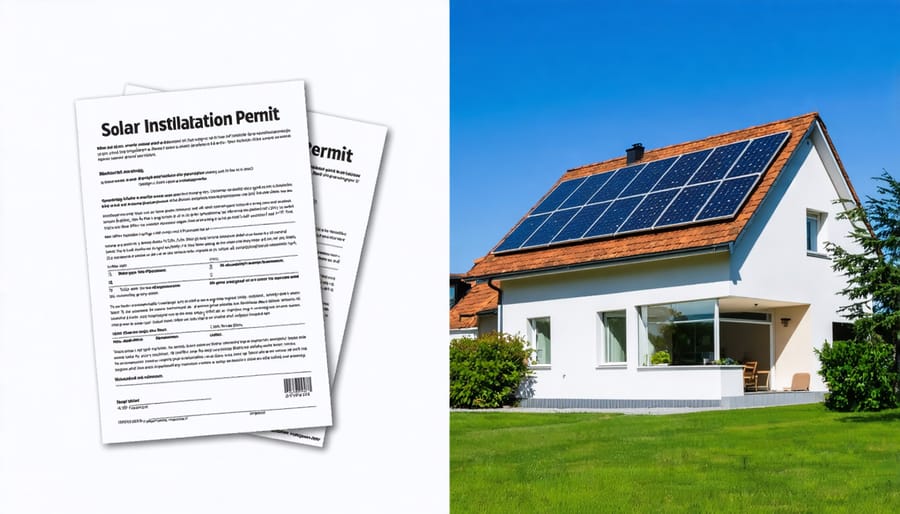
Electrical Code Compliance
The National Electrical Code (NEC) sets crucial safety requirements for all solar installations across the United States. These solar panel safety standards ensure your system operates safely and efficiently while protecting your home and family.
Key NEC requirements include proper grounding of all metal components, appropriate wire sizing and protection, and the installation of rapid shutdown systems that can quickly de-energize your solar array in emergencies. Solar installations must also include clear labeling of system components and disconnect points for first responder safety.
Most states adopt the latest version of the NEC, though implementation dates may vary. Your solar installer should be familiar with both national and local electrical codes, including any state-specific amendments. Before installation begins, ensure your contractor obtains proper electrical permits and schedules necessary inspections with local authorities.
To maintain compliance, work only with certified electricians who specialize in solar installations and keep detailed documentation of all permits and inspections for your records.
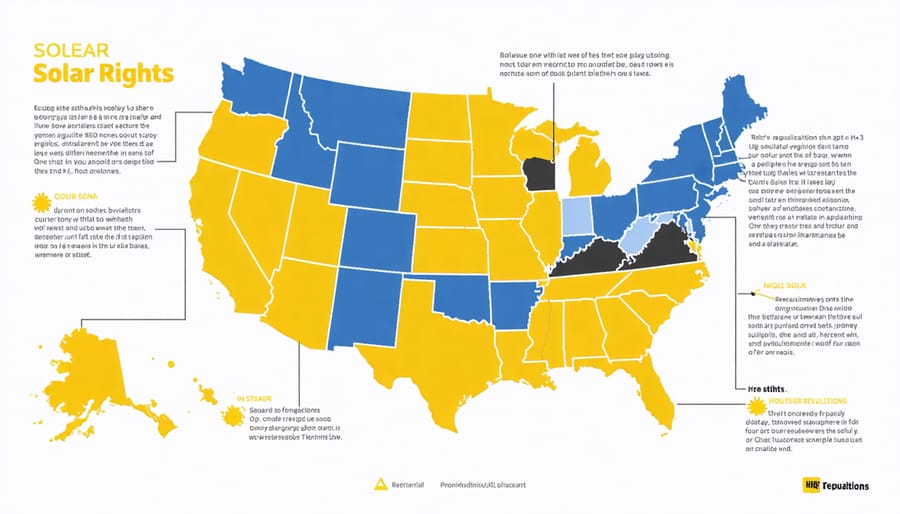
State-Specific Solar Rights and Access Laws
HOA Restrictions
Many states have enacted “solar rights laws” that prevent homeowners associations (HOAs) from outright banning solar panel installations. These laws protect homeowners’ right to generate clean energy while ensuring reasonable aesthetic guidelines are followed.
Currently, 25 states have specific laws limiting HOA restrictions on solar installations. California’s Solar Rights Act is among the strongest, prohibiting HOAs from preventing solar installations unless they pose safety hazards. Florida, Arizona, and Texas also have robust protections for homeowners wanting to go solar.
However, HOAs can still impose certain reasonable restrictions. These typically include:
– Requirements for professional installation
– Guidelines for panel placement and visibility
– Rules about roof mounting methods
– Aesthetic standards for equipment screening
Even in states with solar rights laws, it’s important to:
– Review your HOA’s specific solar installation guidelines
– Submit detailed installation plans for approval
– Work with your installer to meet HOA requirements
– Document all communications with your HOA
– Consider mediation if disputes arise
If your state doesn’t have solar access laws, you can still successfully install solar panels by working closely with your HOA board and choosing a system design that addresses their concerns while maintaining efficiency. Many HOAs are becoming more solar-friendly as clean energy adoption increases nationwide.
Solar Access Rights
Solar access rights protect homeowners’ ability to harness sunlight for their solar energy systems. These laws ensure that neighboring structures, vegetation, or other obstacles don’t unreasonably block sunlight from reaching your solar panels. While federal law doesn’t specifically address solar access rights, many states have enacted their own protective measures.
California leads the way with the Solar Rights Act, which prevents HOAs and local governments from restricting solar installations without good cause. The law also ensures that trees and other obstacles planted after your solar installation cannot significantly reduce your system’s efficiency.
Other states like Massachusetts, Wisconsin, and New Mexico have established solar easements, which are voluntary agreements between property owners. These agreements legally protect your access to sunlight and can be recorded with property deeds, ensuring the protection continues even if neighboring properties change hands.
Some municipalities have adopted solar fence height ordinances and setback requirements that consider the impact of new construction on existing solar installations. These regulations typically require developers to design buildings that won’t cast shadows on neighboring solar panels during peak production hours.
Before installing solar panels, check your local zoning laws and HOA regulations regarding solar access rights. Many states require HOAs to accommodate solar installations, though reasonable restrictions on placement and appearance may still apply.
Environmental Impact Requirements
Wildlife Protection Measures
Many states require solar installations to include specific wildlife protection measures to preserve local ecosystems. Common requirements include installing critter guards or mesh barriers to prevent birds and small animals from nesting under panels. These barriers also protect your system from potential damage caused by wildlife.
Some states mandate maintaining natural vegetation corridors between solar arrays to allow safe passage for local wildlife. In regions with protected species, environmental impact assessments may be required before installation approval. These assessments help determine if additional protective measures are needed, such as seasonal installation restrictions during breeding periods.
Post-installation monitoring may be required in environmentally sensitive areas to ensure wildlife populations aren’t adversely affected. Many states also encourage the creation of pollinator-friendly environments beneath solar arrays by planting native wildflowers and grasses. This approach, known as solar meadows, supports local bee populations while maintaining the efficiency of your solar installation.
For ground-mounted systems, fencing requirements often include wildlife-friendly designs that allow smaller animals to pass through while maintaining security. These measures help create a balance between renewable energy production and wildlife conservation.
Habitat Conservation Rules
Many states require environmental impact assessments before solar installation to protect local wildlife and vegetation. These habitat conservation rules ensure that solar projects don’t disrupt critical ecosystems or endangered species’ habitats. Most regulations focus on maintaining native plant species and establishing wildlife corridors around larger solar installations.
Common requirements include conducting pre-installation surveys to identify protected species, creating buffer zones around sensitive areas, and implementing vegetation management plans. Some states mandate the planting of pollinator-friendly species beneath ground-mounted arrays, which helps support local bee populations while maximizing land use.
For residential installations, these rules typically involve simpler considerations, such as avoiding tree removal or ensuring panels don’t interfere with protected bird nesting areas. Many states offer guidance on maintaining ground cover and managing stormwater runoff to prevent soil erosion.
Homeowners should consult their local planning office early in the process to understand specific habitat protection requirements, as violations can result in project delays or additional costs. Most jurisdictions provide clear guidelines and often work with homeowners to find solutions that balance environmental protection with solar energy goals.
Grid Connection and Net Metering Policies
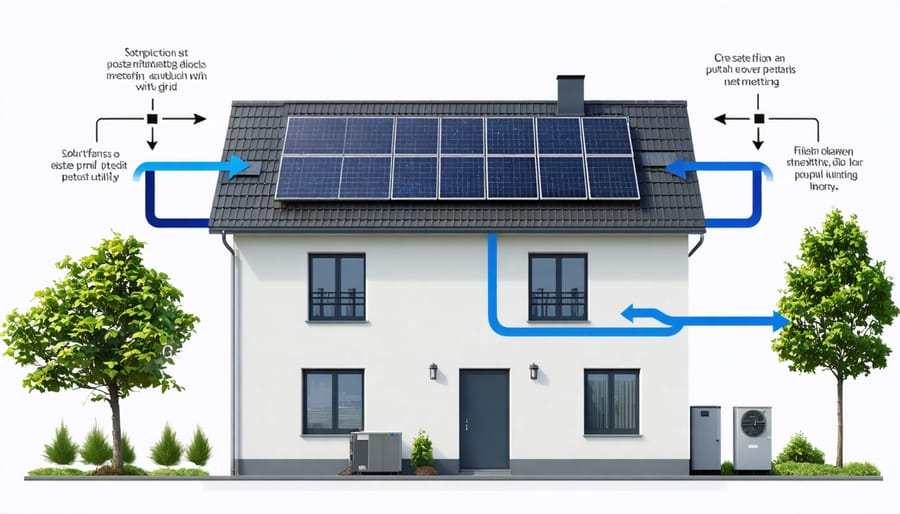
Utility Company Requirements
Before connecting your solar system to the power grid, you’ll need to meet specific requirements set by your local utility company. Most utilities require an interconnection agreement, which outlines the technical and safety standards your solar installation must meet. This agreement ensures your system won’t disrupt the grid’s stability or create safety hazards for utility workers.
Common utility requirements include the installation of a proper disconnect switch, which allows the utility to safely isolate your system during maintenance or emergencies. You’ll also need to install approved meters that can measure both the electricity you draw from the grid and the excess power your system sends back.
Many utilities mandate professional installation by certified contractors and require your system to pass inspection before connection approval. The application process typically involves submitting detailed system specifications, including equipment certifications and site plans.
Some states have standardized these requirements through “interconnection standards,” making the process more straightforward. However, requirements can vary significantly between utilities, even within the same state. Response times for application approval typically range from 2-8 weeks, depending on your location and utility company.
Remember to factor these requirements into your project timeline and budget, as some utilities may charge application or inspection fees. It’s best to contact your utility provider early in the planning process to understand their specific requirements and avoid delays.
Net Metering Variations
Net metering policies vary significantly across states, reflecting different approaches to valuing excess solar energy production. While most states offer some form of net metering, the compensation rates and credit structures can differ substantially. Some states provide full retail rate credits for excess energy, meaning homeowners receive the same rate for energy they produce as what they pay for consumption. Others use avoided-cost rates, which typically offer lower compensation based on the utility’s wholesale energy costs.
Many states have adopted monthly rollover systems for solar energy credits, allowing unused credits to carry forward to future billing periods. Some jurisdictions, like New Jersey and Massachusetts, allow credits to roll over indefinitely, while others, such as California, reset credits annually. A growing number of states are transitioning to “net billing” systems, which separate the rates for energy consumption and production.
Time-of-use considerations also play a role in many states’ policies, with some offering higher compensation for energy produced during peak demand hours. This approach encourages strategic energy production and consumption, helping homeowners maximize their solar investment while supporting grid stability. Understanding your state’s specific net metering structure is crucial for calculating potential savings and planning your solar system’s size effectively.
Finding Your State’s Requirements
Understanding your state’s solar regulations doesn’t have to be complicated. Start by visiting your state government’s energy or environmental protection website, which typically has dedicated sections for renewable energy policies. These official sources provide the most up-to-date information on local requirements and incentives.
Your local utility company is another valuable resource. Contact them directly to learn about grid connection requirements, net metering policies, and any specific paperwork needed for solar installation. Many utilities have dedicated renewable energy departments that can guide you through their specific processes.
Don’t overlook your city or county planning department. They can provide information about building permits, zoning restrictions, and HOA regulations that might affect your solar installation. Some municipalities have streamlined permitting processes specifically for residential solar projects.
Professional solar installers in your area can also be excellent sources of information. They work with these regulations daily and can often explain requirements in plain language. However, it’s always wise to verify their information with official sources.
Keep these key points in mind when researching:
– Building and electrical codes specific to solar installations
– Required permits and associated fees
– Homeowners association restrictions
– Grid interconnection requirements
– Safety and equipment standards
– Available tax incentives and rebates
Consider joining local solar energy groups or online forums where homeowners share their experiences navigating regulations. These communities often provide practical insights and can alert you to recent changes in local requirements.
Remember to document everything you learn and keep copies of relevant regulations. This information will be valuable when working with installers and completing permit applications.
Solar regulations play a vital role in shaping the future of renewable energy adoption across America. As we’ve explored, each state has its unique approach to solar policy, incentives, and requirements, creating a diverse landscape of opportunities for homeowners. Understanding these regulations is crucial for making informed decisions about your solar investment.
Remember that solar regulations are designed to protect both consumers and the grid while promoting sustainable energy adoption. Whether you live in a solar-friendly state with robust incentives or one with emerging policies, there are typically pathways to make solar work for your home.
Take the next step by researching your specific state’s requirements and connecting with local solar installers who understand the regulatory landscape. Consider scheduling a home assessment to understand how solar can benefit your property while ensuring compliance with local regulations. The sooner you start exploring your solar options, the sooner you can begin enjoying reduced energy bills and contributing to a more sustainable future.
Don’t let the complexity of regulations deter you – solar professionals can guide you through the process, ensuring your installation meets all requirements while maximizing available incentives.

